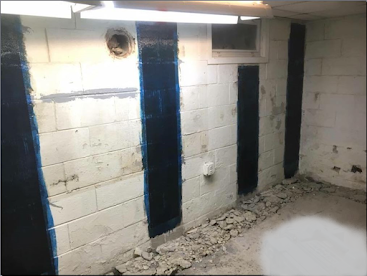Carbon Fiber Foundation Repair Inspection

The first thing I think of when I see a carbon fiber foundation repair is: Is this done properly? So what is carbon fiber? Carbon fiber is a polymer known as graphite fiber. Extremely light weight, and 5 times stronger than steel, 2 times as stiff, and considerably lighter. Normally carbon fiber repairs are must less expensive than other foundation repairs and require no maintenance. Referring to the picture above; how will a home inspector know if carbon fiber was installed properly. So how is it supposed to be installed and when is it recommended for use? Carbon fiber is installed on areas of a wall that is moving (normally bowing), or cracked. The fibers should be installed in the opposite direction of the movement. So, if there is a horizontal crack and the wall is bowing, the fibers should be vertical like the picture above. The area where the carbon fiber is being attached should be ground and cleaned so the epoxy will adhere. A special high strength epoxy is then applied. The carbon fiber strips or matting is then applied and rolled or pressed into place. Some carbon fiber strips are also secured at the top and bottom of the wall.
So what should a home inspector be looking for when inspecting a wall where carbon fiber has been installed?
- Carbon fiber repairs are recommended for a smaller amount of movement or cracking. Significant movement or cracking would require other methods including earth anchors, or rebuilding.
- Drainage should be installed preferably on the inside and outside of the wall
- Epoxy should be visible around the carbon fiber
- The carbon fiber should not be lifting or separating from the wall
- What was the reason (if you can determine) for the carbon fiber reinforcement?
- Is there an engineers scope of work report available?
- Ask for warranty information for your client, (note this in your written report also)
- Was the work performed by a reputable company
- Home inspectors should still report on what you see; movement / cracks / bowing, etc. Including the degree
- Some experts recommend the carbon fiber wall supports should be mechanically attached or epoxyed at the sill plate and at the floor anchoring to the footing.
- Again, check the scope of work and warranty information if available
Related Articles:
- Bridging & Blocking
- Inspecting Floor Trusses
- Inspecting Spiral Staircases
- Structural Insulated Panels
Want To Learn More? Click HERE to Search Our Full Database Of Home Inspector Newsletters.



